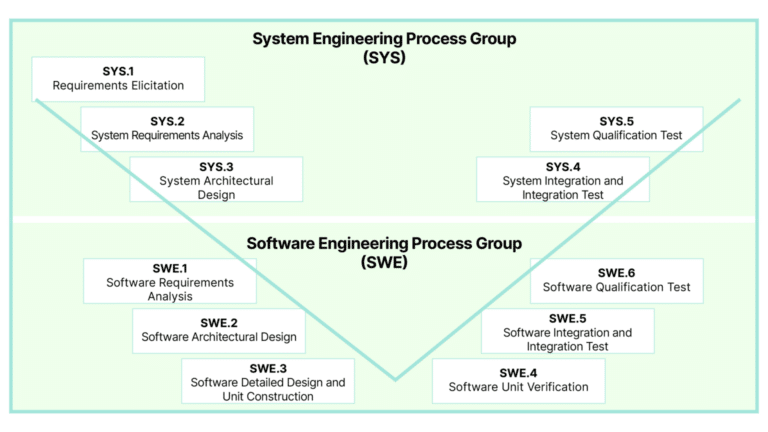Managing ASPICE Compliance with Modern Requirements

Automotive Software Performance Improvement and Capability determination (ASPICE) is a standard derived from the generic SPICE (ISO/IEC 15504) standard. It provides guidelines for car makers to improve software development processes and to assess suppliers.
ASPICE builds on the V-Model. For every system specification on the left side of the ‘V’, there is a corresponding validation and verification on the right side.

Modern Requirements is a world-class requirements management tool to cover the entire requirements engineering lifecycle within ASPICE compliance from eliciting requirements, mapping requirements into system requirements, breaking down requirements into logical services, and auditing software requirements to the corresponding system qualification testing, system integration testing, software qualification testing, software integration testing, and unit testing.
The following list summarizes some of the key features of Modern Requirements that could be used to fill the gap in requirements management during the ASPICE compliance process. These benefits are crucial in helping you ensure that all of the regulatory requirements within your processes are met, resulting in quicker complete compliance, slashed product development cycle times and faster value delivery.
Modern Requirements is seamlessly integrated with Azure DevOps, TFS, and VSTS. It provides one single source of truth for development, requirements management, hazard and risk management, and verification & validation teams to work collaboratively and effectively.
- Smart Docs: An authoring module makes ASPICE compliance more efficient and less error-prone. Bridge the gap between document and information management by authoring requirements in a document view online. Add detailed tables and leverage rich text, images and diagrams, while simultaneously creating and updating work items in the database. Multiple users are allowed to make changes to Smart Docs at the same time without having version problems or needing to check-in/out.
- Copilot4DevOps: ASPICE has hundreds of base practices which a car manufacturer must satisfy. Copilot4DevOps is an AI requirements management tool that helps you stay compliant with ASPICE in a few ways:
- By using the elicitation function, you can generate a detailed list of requirements for automotive software from raw requirements data.
- The analysis function helps you analyze the quality of your requirements for the 6Cs of writing, which ensures requirements written by BAs and PMs accurately state stakeholder needs.
- Finally, Copilot4DevOps enables you to elicit a comprehensive list of elicitation questions (and even suggested answers) with a few clicks. This helps ensure that your automotive software addresses all relevant aspects of ASPICE compliance.
- Version and Variant: In software development, version management helps you keep track of different software versions by reducing conflicts, boosting traceability, and complying with local laws and regulations. You can then keep track of various versions of your automotive software tailored for different automotive markets while staying compliant with ASPICE.
- Trace Analysis: Traceability is a key challenge in ASPICE compliance and requirements on traceability are even stronger in ASPICE than in ISO 26262. Generate a traceability matrix in just seconds by using Modern Requirements to track end-to-end progress. Use the traceability matrix to mitigate risks by connecting functional safety requirements with product specifications, and it tracks requirements against test cases (for V&V), bugs, risks, issues, and change.
- FAQ: Our pre-packaged ASPICE specific question lists help project teams gather robust and comprehensive requirements faster and easier. Users can also refer to over 3000 extra pre-built questions gathered from software and hardware developing processes to facilitate requirements authoring.
- Baseline: Baseline module allows users to take a snapshot of selected requirements at a point in time to allow control and tracking changes to maintain functional safety. Baseline could also be leveraged to reuse requirements across projects to avoid redundant work. It can also be used for branching and merging.
- Review: The Review module allows stakeholders to communicate, review, and approve within the project environment and facilitate change when necessary. This feature lets you connect e-signatures to selected reviews and achieve industry compliance. When nonconformities are identified, corrective tasks can be created directly that allows stakeholders to keep track of all requested changes. With one click of the mouse, users can generate an audit report to record every single review feedback of stakeholders.
- Diagram (Workflow): With Modern Requirements4DevOps, users can build workflows inside the same project environment that can be linked directly to requirements. Based on the workflow input, the system could automatically generate user stories, use cases, and test cases to elicit requirements during the safety analysis process. Diagrams can also be created directly within Smart Docs.
- Smart Reporting: A feature built into Backlogs, Diagram, Smart Docs, Simulation and Use Cases, Trace Analysis, Baseline, and Review modules that makes reporting a breeze. It enables users to format their reports according to the work items structures. The report can be saved as MS-Word, PDF and in HTML format. These reports are configurable by the users.
Conclusions:
ASPICE is a small standard with large coverage around the global automotive industry. Automobile manufacturers face huge challenges when creating, tracing, versioning, documenting and reporting requirements in ASPICE compliance.
Modern Requirements4DevOps includes all of the necessary capabilities to build cohesive and traceable requirements to meet the stringent requirements of ASPICE. With our native Azure DevOps, as well as MR developed capabilities, simple to create Baselines, and always up to date Traceability Matrices, Modern Requirements is fully equipped with all of the tools teams needs.
Fully aligned with V Model, Agile, Scrum, Waterfall, other methodologies and everything in between, Modern Requirements4DevOps makes more easily comply with regulations and provides great transparency and synchronization in hardware and software teams. This way, Modern Requirements empowers you to drive faster with ASPICE.

